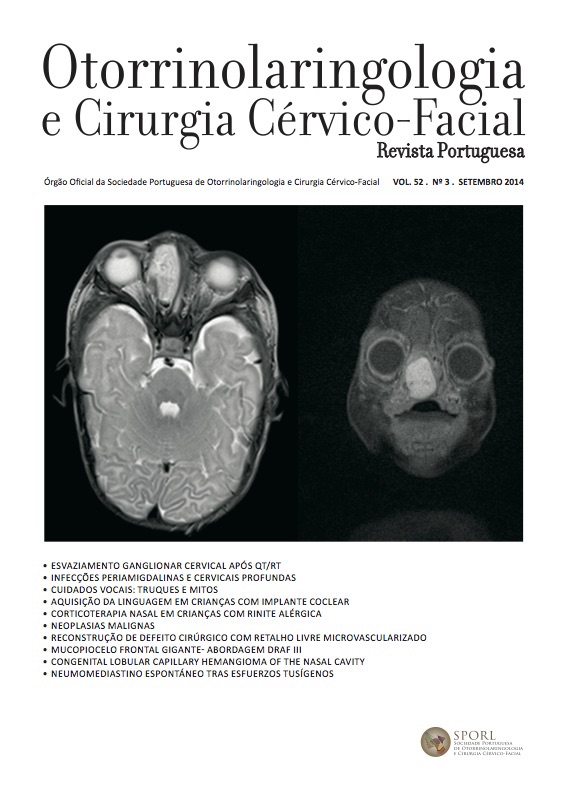Congenital lobular capillary hemangioma of the nasal cavity of an infant - A rare case report
DOI:
https://doi.org/10.34631/sporl.454Keywords:
Lobular capillary hemangioma, pyogenic granuloma, hemangioma, nasal cavity mass, endoscopic nasal surgeryAbstract
Introduction: Lobular capillary hemangioma (LCH), originally referred to as pyogenic granuloma, is a benign rapidly growing vascular lesion of unknown origin, with a microscopically distinctive lobular architecture that affects skin and mucosa. Although LCH of the head and neck is not uncommon, occurrence in the nasal cavity is rare, and even rarer in children.
Material and methods: A retrospective case review of an infant presenting at our pediatric hospital with a mass of the right nasal cavity diagnosed as lobular capillary hemangioma.
Results: This is a review of the history of a 54-days-old child with severe nasal obstruction caused by a mass of right nasal cavity. He had difficulty breathing since birth, which had been progressively worsening. The right nasal cavity mass had increased in size since birth and was responsible for bulging of the right side of nasal pyramid and septum and periorbital edema. After removal of the mass through endonasal surgery with endoscopic control, it was diagnosed as lobular capillary hemangioma.
Conclusions: The authors found in the literature only one case of congenital lobular capillary hemangioma of the nasal cavity. Although rare, lobular capillary hemangioma must be included in the differential diagnosis of nasal cavity masses in the infant population.
Downloads
References
Puxeddu R, Berlucchi M, Ledda GP, Parodo G, Farina D, Nicolai P. Lobular capillary hemangioma of the nasal cavity: a retrospective study on 40 patients. Am J Rhinol 2006; 20:480-4.
Gernon TJ, McHugh JB, Thorne MC. Pathology quiz case 2. Diagnosis: Nasal lobular capillary hemangioma (pyogenic granuloma). Arch Otolaryngology Head Neck Surg. 2010 Sep; 136(9): 930, 932-3.
Benoit MM, Fink DS, Brigger MT, Keamy DG Jr. Lobular capillary hemangioma of the nasal cavity in a five-year-old boy. Otolaryngol Head Neck Surg. 2010 Feb;142(2):290-1
Katori H, Tsukuda M. Lobular capillary hemangioma of the nasal cavity in child. Auris Nasus Larynx. 2005 Jun;32(2):185-8. Epub 2005 Mar 23.
Ozcan C, Apa DD, Görür K. Pediatric lobular capillary hemangioma of the nasal cavity. Eur Arch Otorhinolaryngol. 2004 Sep;261(8):449-51. Epub 2003 Dec 3.
Simo R, de Carpentier J, Rejali D, Gunawardena WJ. Paediatric pyogenic granuloma presenting as a unilateral nasal polyp. Rhinology. 1998 Sep;36(3):136-8.
Ogunleye AO, Nwaorgu OG. Pyogenic granuloma, a cause of congenital nasal mass: case report. Ann Trop Paediatr. 2000
Jun;20(2):137-9.
Wyatt M. Nasal obstruction in children. In: Browning G, Burton M, Clarke R et al. Scott-Brown´s Otorhinolaryngology, Head and Neck Surgery; Seventh edition. Hoddler Arnold; 2008: pp1070-77.
Mills SE, Cooper PH, Fechner RE. Lobular capillary hemangioma: the underlying lesion of pyogenic granuloma. A study of 73 cases from the oral and nasal mucous membranes. Am J Surg Pathol 1980;4:470-9.






